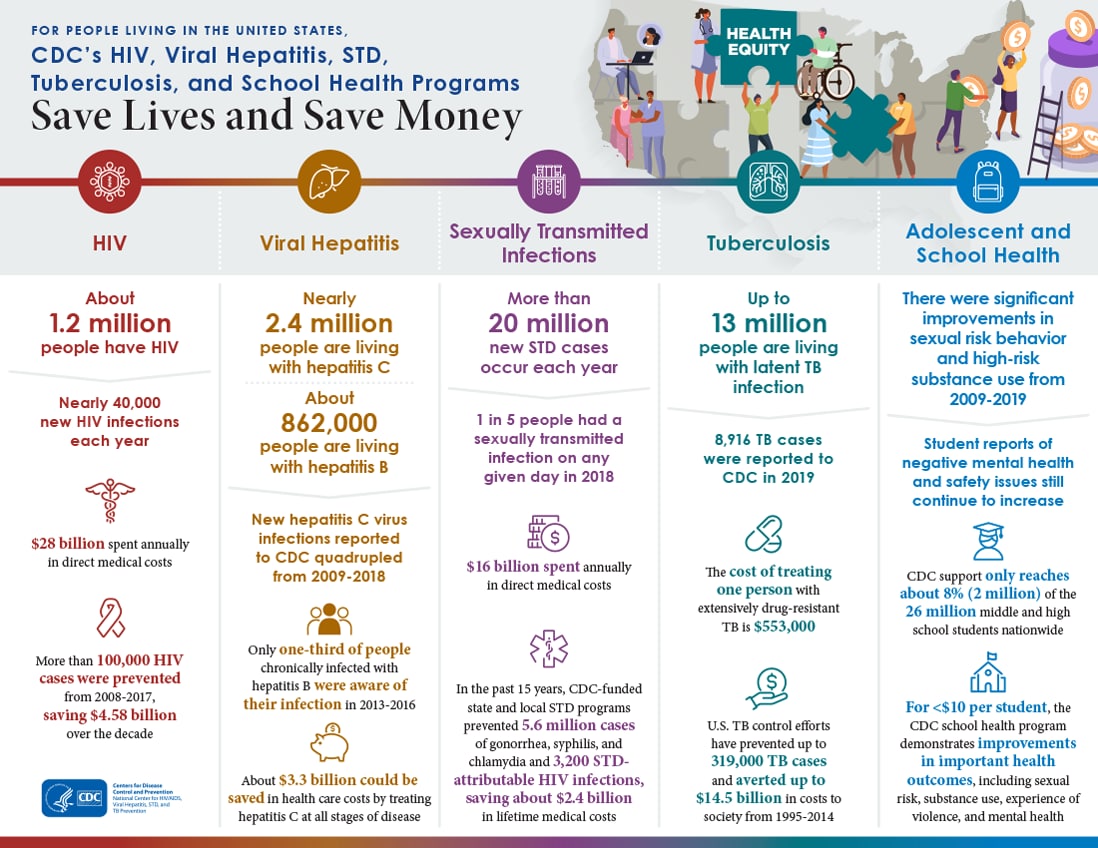CDC’s HIV, Viral Hepatitis, Sexually Transmitted Infections, and Tuberculosis Prevention Budget
Between 2005-2019, CDC-supported state and local STD prevention programs prevented 6.1 million sexually transmitted infections and 3,540 STD-attributable HIV, saving $2.8 billion in lifetime medical costs averted over the past 15 years.
For every $1 CDC spent on HIV testing through the Expanded Testing Initiative, an estimated $2 was saved in direct medical costs.
Between 1995 and 2014, U.S. TB control efforts prevented as many as 319,000 cases and saved up to $14.5 billion in costs to society.
CDC’s programs that prevent and control HIV, viral hepatitis, sexually transmitted infections (STIs), and tuberculosis (TB) protect the nation and help Americans lead healthier and longer lives. CDC works to decrease health disparities while preventing infections throughout the nation and helps to keep teens healthy by educating them on how to avoid these infections.
CDC prioritizes cost-effective, scalable interventions, policies, and research to reduce the incidence of HIV, viral hepatitis, STIs, and TB, all of which have significant personal, societal, and economic costs. Most of CDC investments to prevent and control these conditions fund state, local and territorial health departments, community-based organizations, national organizations, academic institutions, and education agencies.
CDC’s HIV, viral hepatitis, sexually transmitted infections (STIs), tuberculosis (TB) and school health programs have been essential to the nation’s public health infrastructure for decades.
CDC funding and training support field staff, including disease intervention specialists (DIS). DIS are frontline public health staff who help identify individuals who may not know they were exposed to STIs, HIV, and TB. These specially-trained staff then connect patients to testing and treatment. DIS are also a critical piece of the public health infrastructure when emergencies and public health threats emerge, protecting Americans from a wide variety of outbreaks and epidemics, including HIV, TB, Ebola, influenza, Zika, and COVID-19. CDC also provides financial assistance and assigns federal employees with on-the-ground experience to state, tribal, local and territorial health departments to reduce HIV, viral hepatitis, STI, and TB infections, link those who test positive to care and treatment, and prevent death. Upon request from state, tribal, local, and territorial health departments, CDC can provide direct assistance, which may include deploying CDC public health advisors or epidemiologists to assist with disease investigations. Through the American Rescue Plan Act of 2021, NCHHSTP will provide over $1,000,000,000 in funding to support DIS workforce over five years. For more information on the American Rescue Plan funding for DIS workforce please visit: CDC COVID-19 State, Tribal, Local, and Territorial Funding.
CDC uses a comprehensive approach to stop the spread of infectious diseases among people who use drugs. The nation’s public health crisis involving drug use of opioids and other drugs, including methamphetamines and cocaine, is fueling increases in infectious diseases, such as viral hepatitis and HIV.
HIV, viral hepatitis, STI , and TB laboratory services at CDC work around the clock to protect the health of all Americans. These laboratories use vital discoveries and cutting-edge technology, some of which are only available at CDC laboratories.
For people living in the United States, CDC’s HIV, Viral Hepatitis, STD, Tuberculosis, and School Health Programs Save Lives and Save Money
HIV
- About 1.2 million people have HIV
- Nearly 40,000 new HIV infections each year
- $28 billion spent annually in direct medical costs
- More than 100,000 HIV cases were prevented from 2008-2017, saving $4.58 billion over the decade
Viral Hepatitis
- Nearly 2.4 million people are living with hepatitis C
- About 862,000 people are living with hepatitis B
- New hepatitis C virus infections reported to CDC quadrupled from 2009-2018
- Only one-third of people chronically infected with hepatitis B were aware of their infection in 2013-2016
- About $3.3 billion could be saved in health care costs by treating hepatitis C at all stages of disease
Sexually Transmitted Infections
- More than 20 million new STD cases occur each year
- 1 in 5 people had a sexually transmitted infection on any given day in 2018
- $16 billion spent annually in direct medical costs
- In the past 15 years, CDC-funded state and local STD programs prevented 5.6 million cases
- of gonorrhea, syphilis, and chlamydia and 3,200 STD-attributable HIV infections, saving about $2.4 billion in lifetime medical costs
Tuberculosis
- Up to 13 million people are living with latent TB infection
- 8,916 TB cases were reported to CDC in 2019
- The cost of treating one person with extensively drug-resistant TB is $553,000
- S. TB control efforts have prevented up to 319,000 TB cases and averted up to $14.5 billion in costs to society from 1995-2014
Adolescent and School Health
- There were significant improvements in sexual risk behavior and high-risk substance use from 2009-2019
- Student reports of negative mental health and safety issues still continue to increase student
- CDC support only reaches about 8% (2 million) of the 26 million middle and high school students nationwide
For <$10 per student, the CDC school health program demonstrates improvements in important health outcomes, including sexual risk, su



